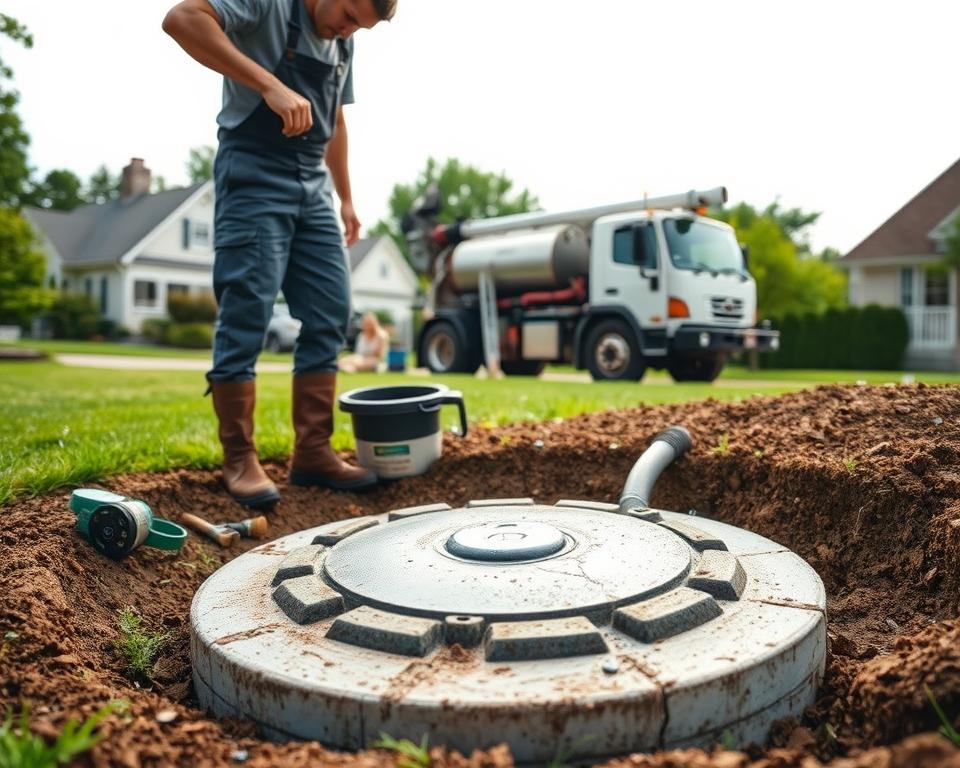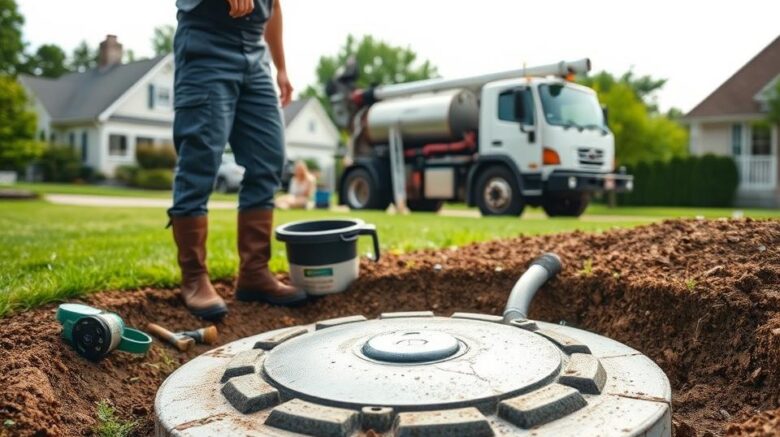RV Wastewater Pump Guide: Crucial Care Guidelines
Have you ever thought about the mechanics of your camper’s waste disposal system? Being aware of the intricacies of your RV waste pump can sidestep mishaps, improving your camping excursions. It’s centered on handling waste efficiently and dodging unpleasant aromas. In this handbook, you’ll discover critical maintenance methods for camper septic pumping. Each strategy is designed to maintain your sewer network’s best operation.
Learning About Your RV Sewage Pump Network
The recreational vehicle waste pump network is indispensable for waste management, making outdoor stays more convenient. It consists of two main tanks: the black-water reservoir for solid waste and the grey-water reservoir for water from sinks and showers. Telling apart these tanks is crucial to ward off clogs and keep your RV operating smoothly.
An RV macerator pump is a popular choice for refuse disposal. It chews up solid waste into fine pieces, simplifying disposal. In contrast, a traditional camper sewage pump is available. It effectively moves waste without shredding, for those wanting a simpler option.
Understanding your RV’s sewage pumping system is vital to stopping problems and ensuring smooth examinations. Operating the system efficiently can prevent messes, uplifting your outdoor adventures.
Importance of Regular Maintenance
Upkeeping your RV sewer pump is imperative for a seamless trip. Without proper servicing, you may face odors, clogs, or backups. These problems can mar your road trips.
Routine checkups thwart such complications and sustain your system’s life. By reviewing hoses and seals, you improve efficiency. A regularly checked RV sewage pump ensures smooth waste disposal, letting you enjoy uninterrupted travels.
Consistent attention also brings financial savings over time. Disregard can cause costly breakdowns, requiring cost-intensive maintenance. Putting resources into regular maintenance keeps your motorhome in prime shape, preserving money long term.
How Often Should You Pump Your RV Septic Tank?
Knowing the right time to pump your RV Septic Tank is essential for its upkeep. It’s suggested to pump every 72–120 hours during use. For brief excursions, after-journey servicing may suffice.
Interval depends on multiple considerations. Tank size and usage level are critical. Best practice is to pump when it reaches two-thirds full. This helps ensure smooth flow and avoid clogs.
Tracking your RV Septic tank levels is crucial for a smooth journey. Oversee properly your camper’s sewage to prevent issues while traveling.

Recommended Tank Emptying Tips
Properly emptying RV tanks is vital for your motorhome’s sanitation and functionality. Always empty first the black tank to let the grey water rinse leftover solids. This approach ward off clogs and ensures smooth operation.
Select a top-grade waste hose for disposal. A reliable hose prevents leaks and ensures connections. Add a tank rinser for a intensive cleanse, using water pressure to remove remaining debris, improving cleanliness.
Complete purging prevents residue buildup, avoiding foul odors and potential issues. To maintain an effective sewage system in your motorhome, adhere to these guidelines:
- Regularly use a tank treatment to manage smells and digest residue.
- Keep an eye on fill levels to avoid overflows.
- Inspect your RV waste pump regularly for clogs and wear.
- Perform a deep tank flush every 4–8 weeks, even during occasional use.
Following these methods enhances your sewage system’s longevity and performance, ensuring enjoyable travels.
Keeping Smells and Blockages at Bay
For a memorable adventure, keeping odors at bay is vital. Maintain adequate water level to aid in waste breakdown, avoiding unpleasant odors. Also, using RV-safe toilet paper helps prevent clogs, avoiding backups.
For enhanced refuse control in campers, try bio-agent additives. These effectively break down waste, easing upkeep. Check the vent line often to keep air moving freely in the plumbing system.
Careful waste habits is crucial to avoiding tank issues. Do not flush wipes, feminine products, and paper towels. These non-biodegradable items can cause serious blockages. Adhering to these guidelines helps maintain a tidier camping environment.
RV Waste Pump Service Tips
Maintaining your RV’s sewer pump system is key for hassle-free trips. Verify seal condition frequently to avoid drips. Faulty seals can cause unexpected spills, harming your RV.
To remove stench and maintain cleanliness, sanitizing is essential. Carry out intensive cleans quarterly to curb scale formation, ensuring the system functions optimally. These steps are essential for maintaining a portable RV pump, promoting durability and smooth service.
Oiling valve mechanisms is another crucial task. It helps ward off seepage and improve functionality. Monitoring tank sensors is vital for accurate readings, preventing overflows and unexpected pump issues. Staying on top of these checks makes your RV adventures neater and more enjoyable.
When to Call in a Pro for Pump-Out
Identifying septic problems ahead can protect you from costly repairs. A key sign you need a pro pump service is slow draining. When sinks and toilets take longer to clear, it often points to clogs. It suggests your system may be backed up.
Ongoing foul scents are another obvious clue of sewage troubles. Unpleasant fumes hanging around despite cleaning suggest trapped waste. It’s crucial to inspect the clear elbow attachment when dumping waste. Visible residue signals it’s time for pro maintenance.
Technicians employ water-jet systems to break up hard obstructions efficiently. Neglecting these signs can escalate into major problems. Therefore, it’s vital to seek help immediately when issues arise.
| Warning Signs of Waste Problems | Possible Action |
|---|---|
| Sluggish Emptying | Look for blockages; schedule pro maintenance |
| Ongoing Foul Scents | Check vents; contact pro service |
| Visible Waste Residue | Call pro for deep cleanse |
Selecting the Ideal RV Waste Grinder
When selecting an RV macerator pump, consider its volume handling, build quality, and compatibility with your RV’s size. A premium macerator is key for smooth sludge processing. This is especially important for RVs requiring frequent disposals. High-end pumps improve sewage handling, ensuring a more pleasant journey.
Multiple designs cater to different preferences. For an well-founded selection, focus on these essential considerations:
- Capacity: Confirm volume capability suits your needs.
- Durability: Choose pumps with robust construction.
- Ease of Use: Look for user-friendly pumps.
- Compatibility: Confirm it matches your fittings.
Taking time to compare when choosing an RV macerator pump improves travel enjoyment and ensures effective waste management.
RV Sewer Pump Problem-Solving
Effective problem-solving for your RV sewer pump is crucial in addressing common sewage issues before they worsen. If you notice slow drainage, unexpected backups, or persistent odors, act quickly. These are clear signs of malfunction requiring attention.
Start with checking the pump, its connections, and hoses. Search for any clogs that could slow flow. Ensure inlet and outlet fittings are leak-free. Also, verify the pump’s power supply for consistency.
If basic checks fail to reveal the issue, listen to the pump’s sound. A unit that’s abnormally loud or unusually silent may have internal damage. Also, inspect for leaks, as these can compound sewage problems. With these troubleshooting steps, many RV owners can find and fix issues early, avoiding costly repairs.
Ongoing Care for Your RV Pump
For continued reliability, dedicate yourself to regular sewer pump upkeep. Clean the system consistently to prevent clogs. Implement and observe a maintenance routine, keeping everyone informed of their roles. This markedly increases your waste system’s lifespan.
Informing yourself and others on correct flushing habits is vital. This forestalls issues and fosters shared responsibility. The result benefits both users and the sewer system.
- Regularly check hoses and fittings
- Maintain clear filter screens
- Book expert service once a year
- Apply recommended conditioners
Abiding by these practices prolongs your camper’s sewage system’s durability and keeps it functional, making travels more enjoyable.
To Summarize
Keeping your RV sewer pump in prime condition is key for hassle-free camping adventures. Regular attention to RV sewer system maintenance drastically lowers problem risks, letting you focus in the journey. By understanding your system and using reliable sewage methods, your trips will be free of waste management woes.
Implementing the critical tips from this guide boosts RV waste management and uplifts your travel comfort and safety. Ensure pump reliability by following best upkeep practices and resolving potential issues promptly.
Keeping informed about your RV sewer system is rewarding. It secures homely comforts while exploring. Here’s to joyous and untroubled journeys!
FAQ
How can I tell it’s time to empty my RV Septic tank?
Service the tank at two-thirds fullness to optimize flow.
Black tank vs. grey tank: what’s the difference?
The black tank holds toilet waste. Whereas, the grey tank collects water from basins and showers.
When to service my RV sewer pump?
Inspect and sanitize system about every three months.
Which products are best for RV sewer pump care?
Opt for biological tank additives.
What prevents blockages in RV plumbing?
Use only RV-safe toilet paper.
What signs indicate I need professional RV pump-out?
Persistent smells or gurgling indicate pro help.
Making your RV macerator pump work better?
Select a correctly sized pump for your RV.
Deep cleaning checklist for RV sewer system?
Clean sensors and lubricate valves.
Maintaining my RV sewer system over time?
Adopt regular deep cleans and consistent sanitation.
What’s the pumping interval for frequent RV use?
Service tank frequently for group travel or heavy usage.
